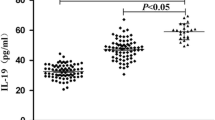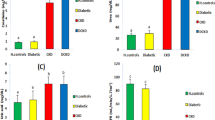Abstract
Background
Diabetic nephropathy (DN) is a micro-chronic diabetic consequence induced by metabolic and hemodynamic abnormalities. Free radicals react with other critical cellular components, causing progression of aberrant renal function.
Objective
This case control study was aimed to determine the role of IL-6 and IL-18 in diabetic nephropathy in Pakistani population.
Methods and materials
The study's subjects (n = 180 from Lahore, Gujranwala, and Karachi) were divided into control, diabetes mellitus (DM) and diabetic nephropathy (DN) groups. The serum concentration of IL-6 & IL-18 were determined by enzyme-linked immunosorbent assay (ELISA). The expression analysis of IL-6 & IL-18 were performed by Real Time PCR.
Results
The significant increase in serum levels of IL-6 were observed among the control, DM and DN groups (15.3 ± 24.1 pg/ml, 34.7 ± 24.0 pg/ml, 52.6 ± 33.2 pg/ml) whereas no significant difference was observed in serum levels of IL-18. The expression analysis of IL-6 was increased by more than forty three fold in DN group (n-fold = ~43.6) as compared to DM & control whereas the expression profile of IL-18 decreased in DN group (n-fold = ~0.89). In DN group the correlation analysis revealed direct association of GFR with serum IL-6 (r = 0.1114) & inverse relationship with serum IL-18 (r = − 0.097). In multiple regression analysis using GFR as the dependent variable, BMI and expression of IL-18 were determinants in DM subjects, but only uric acid in DN subjects.
Conclusion
The present study implicates that increased expression of IL-6 and decreased of IL-18 was associated with development of DN in Pakistani population.
Similar content being viewed by others
References
Egan AM, Dinneen SF (2019) What is diabetes? Medicine. https://doi.org/10.1016/j.mpmed.2018.10.002
Chatterjee S, Khunti K, Davies MJ (2017) Type 2 diabetes. Lancet. https://doi.org/10.1016/S0140-6736(17)30058-2
Donate-Correa J, Martín-Núñez E, Muros-de-Fuentes M, Mora-Fernández C, Navarro-González JF (2015) Inflammatory cytokines in diabetic nephropathy. J Diabetes Res. https://doi.org/10.1155/2015/948417
Navarro-Gonzalez JF, Mora-Fernandez C (2008) The role of inflammatory cytokines in diabetic nephropathy. J Am Soc Nephrol. https://doi.org/10.1681/ASN.2007091048
Ahmad T, Ulhaq I, Mawani M, Islam N (2017) Microalbuminuria in Type-2 Diabetes Mellitus; the tip of iceberg of diabetic complications. Pakistan J Med Sci 33(3):519. https://doi.org/10.2669/pjms.333.12537
Sprague AH, Khalil RA (2009) Inflammatory cytokines in vascular dysfunction and vascular disease. Biochem pharmacol. https://doi.org/10.1016/j.bcp.2009.04.029
Yaribeygi H, Atkin SL, Sahebkar A (2019) Interleukin-18 and diabetic nephropathy: a review. J Cell Physiol 234(5):5674–5682. https://doi.org/10.1002/jcp.27427
Mansoor G, Tahir M, Maqbool T, Abbasi Q, Hadi F, Shakoori TA, Ullah I (2022) Increased expression of circulating stress markers, inflammatory cytokines and decreased antioxidant level in diabetic nephropathy. Medicina 58(11):1604. https://doi.org/10.3390/medicina58111604
Lim AK, Tesch GH (2012) Inflammation in diabetic nephropathy. Mediators Inflamm. https://doi.org/10.1155/2012/146154
Donate-Correa J, Ferri CM, Sánchez-Quintana F, Pérez-Castro A, González-Luis A, Martín-Núñe E, Mora-Fernández C, Navarro-González JF (2021) Inflammatory cytokines in diabetic kidney disease: pathophysiologic and therapeutic implications. Front Med. https://doi.org/10.3389/fmed.2020.628289
Rio DC, Ares M, Hannon GJ, Nilsen TW (2010) Purification of RNA using TRIzol (TRI reagent). Cold Spring Harbor Protoc 6:5439. https://doi.org/10.1101/pdb.prot5439
Duran-Salgado MB, Rubio-Guerra AF (2014) Diabetic nephropathy and inflammation. World J Diabetes 5(3):393. https://doi.org/10.4239/wjd.v5.i3.393
Lopez-Parra V, Mallavia B, Egido J, Gomez-Guerrero C (2012) Immunoinflammation in diabetic nephropathy: molecular mechanisms and therapeutic options. Diabetic Nephrop. https://doi.org/10.5772/34541
Wang T, Zhao Z, Wang G, Li Q, Xu Y, Li M, Hu R, Chen G, Su Q, Mu Y, Tang X (2021) Age-related disparities in diabetes risk attributable to modifiable risk factor profiles in Chinese adults: a nationwide, population-based, cohort study. Lancet Healthy Long. https://doi.org/10.1016/S2666-7568(21)00177-X
Al-Rubeaan K, Youssef AM, Subhani SN, Ahmad NA, Al-Sharqawi AH, Al-Mutlaq HM, David SK, AlNaqeb D (2014) Diabetic nephropathy and its risk factors in a society with a type 2 diabetes epidemic: a Saudi National Diabetes Registry-based study. PloS ONE. https://doi.org/10.1371/journal.pone.0088956
Lou J, Jing L, Yang H, Qin F, Long W, Shi R (2019) Risk factors for diabetic nephropathy complications in community patients with type 2 diabetes mellitus in Shanghai: logistic regression and classification tree model analysis. Int J Health Plann Manage 34(3):1013–1024. https://doi.org/10.1002/hpm.2871
Hu F, Zhang T (2020) Study on risk factors of diabetic nephropathy in obese patients with type 2 diabetes mellitus. Int J Gen Med 13:351. https://doi.org/10.2147/IJGM.S255858
Chen HM, Shen WW, Ge YC, Zhang YD, Xie HL, Liu ZH (2013) The relationship between obesity and diabetic nephropathy in China. BMC Nephrol 14(1):1–9. https://doi.org/10.1186/1471-2369-14-6
Nata N, Rangsin R, Supasyndh O, Satirapoj B (2020) Impaired glomerular filtration rate in type 2 diabetes mellitus subjects: a nationwide cross-sectional study in Thailand. J Diabetes Res. https://doi.org/10.1155/2020/6353949
Agrawal NK, Kant S (2014) Targeting inflammation in diabetes: Newer therapeutic options. World J Diabetes 5(5):697. https://doi.org/10.4239/wjd.v5.i5.697
Fadaei R, Bagheri N, Heidarian E, Nouri A, Hesari Z, Moradi N, Ahmadi A, Ahmadi R (2020) Serum levels of IL-32 in patients with type 2 diabetes mellitus and its relationship with TNF-α and IL-6. Cytokine. https://doi.org/10.1016/j.cyto.2019.154832
Ayelign B, Negash M, Andualem H, Wondemagegn T, Kassa E, Shibabaw T, Akalu Y, Molla MD (2021) Association of IL-10 (− 1082 A/G) and IL-6 (− 174 G/C) gene polymorphism with type 2 diabetes mellitus in Ethiopia population. BMC Endocr Disord 21(1):1–8. https://doi.org/10.1186/s12902-021-00738-1
Bashir H, Bhat SA, Majid S, Hamid R, Koul RK, Rehman MU, Din I, Bhat JA, Qadir J, Masood A (2020). Role of inflammatory mediators (TNF-α, IL-6, CRP) biochemical and hematological parameters in type 2 diabetes mellitus patients of Kashmir India. Medical journal of the Islamic Republic of Iran. https://doi.org/10.34171/mjiri.34.5
Lu ZF, Doulabi BZ, Wuisman PI, Bank RA, Helder MN (2007) Differentiation of adipose stem cells by nucleus pulposus cells: configuration effect. Biochem Biophy Res Commun 359(4):991–6. https://doi.org/10.1016/j.bbrc.2007.06.002
Su H, Lei CT, Zhang C (2017) Interleukin-6 signaling pathway and its role in kidney disease: an update. Front Immunol 21(8):405. https://doi.org/10.3389/fimmu.2017.00405
Akbari M, Hassan-Zadeh V (2018) Hyperglycemia affects the expression of inflammatory genes in peripheral blood mononuclear cells of patients with type 2 diabetes. Immunol Investig 47(7):654–65. https://doi.org/10.1080/08820139.2018.1480031
Sueud T, Hadi NR, Abdulameer R, Jamil DA, Al-Aubaidy HA (2019) Assessing urinary levels of IL-18, NGAL and albumin creatinine ratio in patients with diabetic nephropathy. diabetes & metabolic syndrome. Clin Res Rev 13(1):564–8. https://doi.org/10.1016/j.dsx.2018.11.022
Fujita T, Shimizu C, Fuke Y, Satomura A, Abe M, Kaizu K, Soma M (2011) Serum interleukin-18 binding protein increases with behavior different from IL-18 in patients with diabetic nephropathy. Diab Res Clin Pract 92(3):e66–e69. https://doi.org/10.1016/j.diabres.2011.02.028
Wada J, Makino H (2013) Inflammation and the pathogenesis of diabetic nephropathy. Clin Sci 124(3):139–152. https://doi.org/10.1042/CS20120198
Lin X, Yuan J, Zhao Y, Zha Y (2015) Urine interleukin-18 in prediction of acute kidney injury: a systemic review and meta-analysis. J Nephrol 28(1):7–16. https://doi.org/10.1007/s40620-014-0113-9
Tsutsumi N, Yokota A, Kimura T, Kato Z, Fukao T, Shirakawa M, Tochio H (2019) An innate interaction between IL-18 and the propeptide that inactivates its precursor form. Sci Rep 9(1):1–9. https://doi.org/10.1038/s41598-019-42661-5
Chi K, Geng X, Liu C, Cai G, Hong Q (2020) Research progress on the role of inflammasomes in kidney disease. Med Inflamm. https://doi.org/10.1155/2020/8032797
Tavalae M, Rahmani M, Drevet JR, Nasr-Esfahani MH (2022) The NLRP3 inflammasome: molecular activation and regulation in spermatogenesis and male infertility; a systematic review. Basic Clin Androl 32(1):1–11. https://doi.org/10.1186/s12610-022-00157-9
Yaribeygi H, Farrokhi FR, Rezaee R, Sahebkar A (2018) Oxidative stress induces renal failure: a review of possible molecular pathways. J Cell Biochem 119(4):2990–2998. https://doi.org/10.1002/jcb.26450
Fatima SS, Jamil Z, Abidi SH, Nadeem D, Bashir Z, Ansari A (2017) Interleukin 18 polymorphism as an inflammatory index in metabolic syndrome a preliminary study. World J Diabetes 8(6):304. https://doi.org/10.4239/wjd.v8.i6.304
Zilverschoon GR, Tack CJ, Joosten LA, Kullberg BJ, Van Der Meer JW, Netea MG (2008) Interleukin-18 resistance in patients with obesity and type 2 diabetes mellitus. Int J Obes 32(9):1407–1414. https://doi.org/10.1038/ijo.2008.109
Edwards NL (2008) The role of hyperuricemia and gout in kidney and cardiovascular disease. Clevel Clin J Med 1(75):S13–S16. https://doi.org/10.3949/ccjm.75.Suppl_5.S13
Jalal DI, Maahs DM, Hovind P, Nakagawa T (2011) Uric acid as a mediator of diabetic nephropathy. InSeminars Nephrol 31(5):459–465. https://doi.org/10.1016/j.semnephrol.2011.08.011
Barra S, Providência R, Silva J, Gomes PL, Seca L, Nascimento J, Leitão-Marques A (2012) Glomerular filtration rate: which formula should be used in patients with myocardial infarction? Rev Port Cardiol 31(7–8):493–502. https://doi.org/10.1016/j.repce.2012.05.003
Sah OSP, Qing YX (2015) Associations between hyperuricemia and chronic kidney disease: a review. Nephro Urol Month. https://doi.org/10.5812/numonthly.7(3)2015.27233
Acknowledgements
We would like to express our deepest gratitude to the doctors of all hospitals that participated as well as the patients themselves for their invaluable assistance with the clinical evaluation and the collecting of blood samples. The authors appreciate Dr. Farhana Rasheed, Dr. Amaan and Dr. Nimra Yaseen for patient identification and blood sampling. We also appreciate Umair Rasheed's help in blood sampling and travel assistance.
Funding
This research was funding by Lahore College for Women University (LCWU), Lahore grant number by TR-158/6523.
Author information
Authors and Affiliations
Contributions
MM: data and sample collection, research work, writing—original draft preparation, results analysis, editing, visualization; SS: supervision, conceptualization, methodology, manuscript review, statistical analysis; SN: methodology, data analysis, manuscript review; TF: supervision, data handling, manuscript review; FM: resources, manuscripit review and editing; MC: identification of patients and blood sampling, manuscript review; MS: identification of patients and help in blood sampling. data handling, manuscript review and approval. All named authors meet the International Committee of Medical Journal Editors (ICMJE) criteria for authorship for this article, take responsibility for the integrity of the work as a whole, and have given their approval for this version to be published.
Corresponding author
Ethics declarations
Ethical approval
The study was conducted according to the guidelines of the Declaration of Helsinki, and approved by the Institutional Ethical Review Committee of Lahore College for Women University, Lahore. (No. REF/NO/LCWU/ZOO/586-; Dated: 18-01-2019). We also received IRB approval letter from Shaikh Zayed Medical Complex, Lahore (IRB ID: SZMC/IRB/Internal/265/2020). We received permission letter of blood sampling from Civil Hospital. Karachi (REF NO: 12449; Date: 16-11-2020) and DHQ, Hospital for Gujranwala (Memo # 21; Date: 27-7-2020).
Consent to participate
Prior to their participation, all of the participants gave their informed consent, and the data were either pseudonymized or anonymized, depending on the circumstance.
Competing interests
The authors state that they have no conflicts of interest.
Additional information
Publisher's Note
Springer Nature remains neutral with regard to jurisdictional claims in published maps and institutional affiliations.
Supplementary Information
Below is the link to the electronic supplementary material.
11033_2023_8249_MOESM1_ESM.docx
Supplementary file 1 (DOCX 22 KB)—Table S1: Demographic and Biochemical characteristics of Lahore, Gujranwala and Karachi population. Table S2: Correlation analysis of Serum IL-6, Serum IL-18, IL-6 Expression and IL-18 Expression with clinical risk factor in the control , diabetic and Diabetic nephropathy subjects of Lahore. Table S3: Correlation analysis of Serum IL-6, Serum IL-18, IL-6 Expression and IL-18 Expression with clinical risk factor in the control , diabetic and Diabetic nephropathy subjects of Gujranwala. Table S4: Correlation analysis of Serum IL-6, Serum IL-18, IL-6 Expression and IL-18 Expression with clinical risk factor in the control , diabetic and Diabetic nephropathy subjects of Karachi.
Rights and permissions
Springer Nature or its licensor (e.g. a society or other partner) holds exclusive rights to this article under a publishing agreement with the author(s) or other rightsholder(s); author self-archiving of the accepted manuscript version of this article is solely governed by the terms of such publishing agreement and applicable law.
About this article
Cite this article
Maqsood, M., Sharif, S., Naz, S. et al. Expression of pro-inflammatory cytokines (IL-6 & IL-18) exacerbate the risk of diabetic nephropathy in the Pakistani population. Mol Biol Rep 50, 3249–3257 (2023). https://doi.org/10.1007/s11033-023-08249-z
Received:
Accepted:
Published:
Issue Date:
DOI: https://doi.org/10.1007/s11033-023-08249-z




